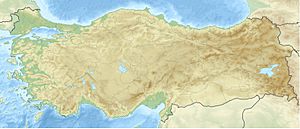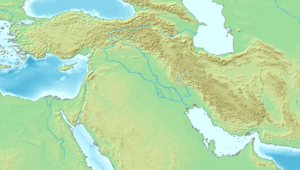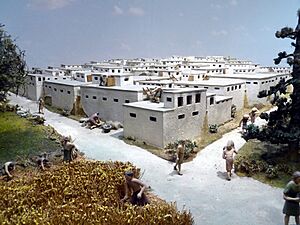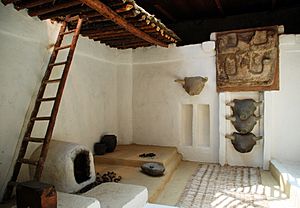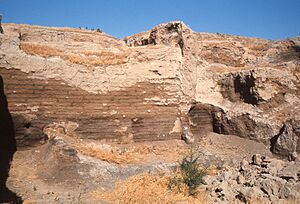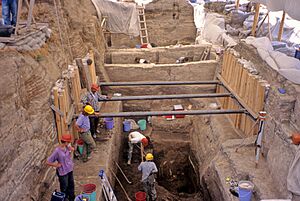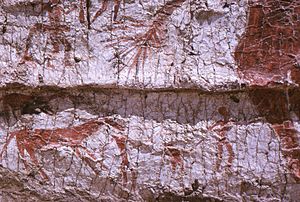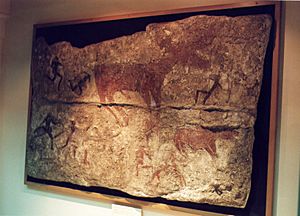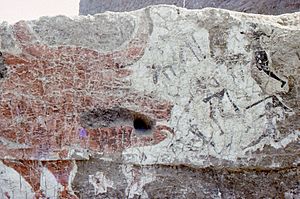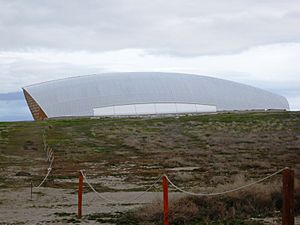Çatalhöyük facts for kids
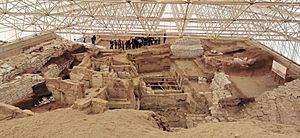
Ruins of Çatalhöyük
|
|
| Location | Küçükköy, Konya Province, Turkey |
|---|---|
| Region | Anatolia |
| Coordinates | 37°40′00″N 32°49′41″E / 37.66667°N 32.82806°E |
| Type | Settlement |
| History | |
| Founded | Approximately 7100 BC; 9125 years ago |
| Abandoned | Approximately 5700 BC; 7725 years ago |
| Periods | Neolithic to Chalcolithic |
| Official name | Neolithic Site of Çatalhöyük |
| Type | Cultural |
| Criteria | iii, iv |
| Designated | 2012 (36th session) |
| Reference no. | 1405 |
| Region | Western Asia |
Çatalhöyük (say "cha-tal-HOO-yuhk") is the name of a very old settlement in southern Turkey. It was a large village or early town that existed from about 7500 BC to 5600 BC. This means it was around during the Neolithic (New Stone Age) and Chalcolithic (Copper Age) periods. In 2012, Çatalhöyük became a UNESCO World Heritage Site, which means it's a very important place for everyone to protect.
The name Çatalhöyük comes from Turkish words. Çatal means "fork," and höyük means "mound" or "hill." This name describes the site well, as it's a large mound of earth built up over thousands of years by people living there. The settlement is located in the Konya Plain, not far from the modern city of Konya. It's also near an old volcano called Mount Hasan. A river once flowed between the two main parts of the settlement, which helped with farming.
Contents
Discovering Çatalhöyük
The site of Çatalhöyük was first found and explored by an archaeologist named James Mellaart in 1958. He led bigger digs between 1961 and 1965. His work showed that this part of Turkey was home to a very advanced culture during the Stone Age. Mellaart's team found 18 different layers of buildings. Each layer showed a different time period of the settlement. The oldest buildings date back to about 7100 BC.
After Mellaart faced some issues, work at the site stopped for many years. Then, in 1993, new excavations began. These were led by Ian Hodder from the University of Cambridge. Hodder's team worked there until 2018. They used new ways to study the site, including digital tools and involving the local community. Their goal was to learn even more about how people lived there.
Today, excavations are still happening at Çatalhöyük. They are now led by Ali Umut Türkcan from Anadolu University.
Life in the Ancient Village
Çatalhöyük was made up of many houses built very close together. There were no obvious public buildings like temples or town halls. The houses were made of mudbrick and were packed together like a honeycomb. There were no streets or paths between the homes. Instead, people walked across the rooftops!
To get into their houses, people used ladders or stairs to climb down through holes in the ceiling. These ceiling openings also let out smoke from their cooking fires. Inside, the houses usually had two main rooms for daily activities like cooking and making things. They also had smaller rooms for storage. All the walls and floors were covered in smooth plaster.
The people of Çatalhöyük kept their homes very clean. Archaeologists found very little trash inside the buildings. Instead, they found piles of rubbish, like food waste and ash, outside the village. Many daily activities probably happened on the rooftops, especially when the weather was good. Over time, when a house got old, people would tear down part of it and build a new one on top. This is how the large mound of Çatalhöyük grew over thousands of years.
Burial Customs
The people of Çatalhöyük buried their dead right inside their village. Human remains have been found under the floors of houses, especially under hearths (fireplaces) and sleeping platforms. Bodies were often placed in baskets or wrapped in reed mats.
Sometimes, bodies were left outside for a while before their bones were gathered and buried. In some cases, people would even remove the head from a buried skeleton. These heads might have been used in special rituals. Some skulls were covered in plaster and painted to look like faces. This was a custom seen in other ancient sites like Jericho.
Art and Symbols
The people of Çatalhöyük created amazing art. They painted colorful murals on the walls inside and outside their homes. They also made small figurines. Many of these figurines were of women, like the famous Seated Woman of Çatalhöyük.
Even though no temples have been found, the burials, murals, and figurines suggest that the people had a rich spiritual life. Some rooms with lots of art might have been special places for rituals or meetings. Common images included hunting scenes, pictures of wild cattle called aurochs, and vultures flying over headless figures. They also carved figures of animals, like lionesses, on their walls.
Animal heads, especially from cattle, were often mounted on walls. One famous painting from Çatalhöyük shows a village with two mountain peaks in the background. Some people think this is the world's oldest map or the first landscape painting. However, other experts believe it might be a painting of a leopard skin or a decorative design, not a map.
Beliefs and Figurines
Many small figures have been found at Çatalhöyük. James Mellaart, the first archaeologist, thought that the female figurines represented a powerful female deity or "Mother Goddess." He believed these figures were very important in their religion. He found them in places he thought were shrines. For example, the famous seated goddess with two lionesses was found in a grain storage bin. Mellaart thought this meant she protected the harvest.
However, later excavations by Ian Hodder and his team found many more figurines. They discovered that most of the figures were of animals, not women. Less than 5% of the figurines were female. Hodder's team also found a unique figurine that looked like a woman with a very thin, almost skeletal back. This made them think that the female figures might have been connected to ideas about death and life, not just a Mother Goddess.
Modern research suggests that men and women in Çatalhöyük had equal social status. They ate the same foods and had similar roles in the community. The number of male and female skulls found in burials is also about equal. This means that Çatalhöyük was likely not a society ruled by women (a matriarchy) or by men (a patriarchy). Instead, it seems people had a balanced way of life.
How They Lived and Traded
Çatalhöyük seems to have been an egalitarian society. This means that everyone was mostly equal. No houses have been found that look like they belonged to kings, queens, or special priests. Men and women had similar social standing and ate the same foods. Children learned by watching adults do daily tasks and rituals.
The way the village was built suggests that families were very close. People might have been divided into two groups living on opposite sides of the town. These groups might have married each other, which helped the settlement grow so large.
The people of Çatalhöyük were skilled farmers. They grew cereals like wheat and barley, as well as peas. They also gathered almonds, pistachios, and fruits from nearby hills. They domesticated sheep and started to domesticate cattle. However, hunting animals was still a very important way to get food.
They were also good at making things. Pottery and tools made from obsidian (a type of volcanic glass) were important industries. They probably used obsidian tools themselves and also traded them. They might have traded obsidian for things like seashells from the Mediterranean Sea and flint from Syria. While private belongings existed, many tools were shared. Some research suggests that over time, the village might have started to have more differences in wealth between families.
Visiting the Museum
If you visit Çatalhöyük today, you can explore a brand-new museum that opened in 2023. It was built by the Konya municipality. In October 2024, a bookshop and cafe were added. Visitors from other countries pay a small fee to enter.
The museum has many interactive information kiosks, some in English. You can learn all about the discoveries in eight different rooms. There's even an underground reconstruction of a typical house from 9,000 years ago, so you can see what it was like to live there!
See also
 In Spanish: Çatalhöyük para niños
In Spanish: Çatalhöyük para niños
- Körtiktepe
- Göbekli Tepe
- Boncuklu Höyük
- Cities of the ancient Near East
- Cucuteni–Trypillian culture
- Kamyana Mohyla
- List of largest cities throughout history
- List of Stone Age art
- Matriarchy
- Neolithic Revolution
- Old Europe (archaeology)
- Sacred bull
- Venus figurines


